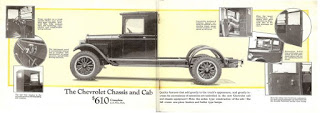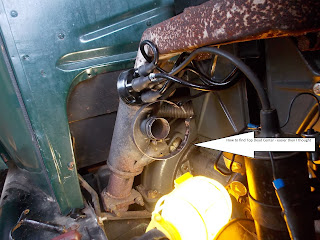1927 Markings
When I first bought the truck, the son told me that his dad
bought the truck and then he had to make the bed of the truck and he did from
trees on his property. I had no reason to doubt him when I bought
the truck. I knew nothing about the truck, the history of early
trucks, but since then, have wanted to find out anything I could on the
truck.
1.) As for the cab, 1927 was the first year
that Chevy offered a factory cab. You could make your own bed or go
to a variety of body builders. The other option was that the truck could be
bought with a commercial cowl and the buyer could make his/her own body or get
a whole body from a body builder.
2.) What identifies it as a 1927? There
are a number of clues, such as the date the engine was cast,
whether it has one or two exhaust ports, the number
of spokes on the wheels, the front profile of the radiator shell, the shape of
the headlights, the headlight rims, and the fact that does not
have brakes on the front wheels are all clues.
The engine block is stamped with
the following:
Which I have learned means
T = Truck and was the 4,151,256 engine block made that year.
B = February
28 = the 28th day
8 = 1928
The cylinder head is stamped
348540 B
25 8
B = February
25 = 25th day
8 = 1928
Not sure what the 11 means yet under the date.
CYLINDER HEADS: The casting
# of the later 1928 Cylinder Head from 1 January 1928 was # 348540 and the
Cylinder Block # 348532. This new Head featured larger valves,
increased valve lift and a 2-piece exhaust manifold, with 2
matching exhaust ports together with Compression Ratio from
4.3:1 of 4.5:1 as well. To summarize the known casting numbers
for Cylinder Heads are: # 348540 DECEMBER 1927 TO OCTOBER 1928 AND
THEN FOR FURTHER CASTINGS IN LATER YEARS: # 348540
Also at about the same time, the Delco-Remy
Distributor was upgraded to an automatic advance type and the carburetor was
improved from the Carter C-RX-O to the C-RAJX-O,
Part # 346896 which matched up the larger cylinder head inlet ports used with
the larger valves [the later carburetor will not fit the earlier head], another
reason for distinguishing motors with a “TR” prefix.
3.) The engine head is from 1928 because of the two exhaust ports. The exhaust manifold is an aftermarket manifold that would've had sheet metal around it and fed hot air to a heat vent in the cab.
4.) This is a 4-speed (which has the reverse lockout lever)
was optional in '27 and standard for '28.
5. Is it a 1/2 ton or 1-ton truck?
One big clue is the number of rim keepers on the
wheels. 1/2 ton = 4, 1 ton = 6.
Other comments I found
If the truck is in the same shape as in the photos, you
are starting with a great, near stock truck! My druthers would to
fix it mechanically, recover the seat, and drive it AS IS.
It's only original once. Being a 1-ton
truck, it will go slower than the cars because of the high gear ratio in the
rear axle. That's okay because this beast will not stop on a dime.













Comments
Post a Comment